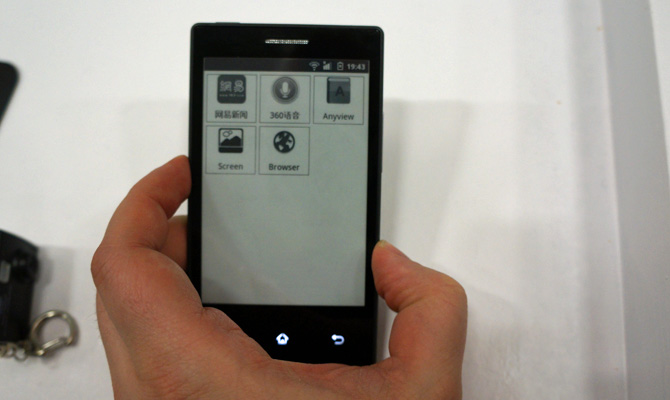E Ink Android Phone Lasts a Week, Weighs Next to Nothing
Who would want a smartphone with a grayscale E Ink screen? Anyone who want days of battery life, superior outdoor readability and low cost should be interested in using the technology in a phone. At Mobile World Congress this week, we got our hands on a prototype Android smartphone with an e-Ink screen and were blown away by just how light it was about how sharp text looked on its screen and how long it could last.
Not keen on giving up your full-color, full HD display on your phone? E Ink technology should be coming soon to back covers for phones, supplying info at a glance without draining your battery.
The device we used has no official name, because it's one of only a handful of prototypes made by eInk, the company behind the grayscale screens that power so many popular devices like the Kindle and Nook. Our demo came courtesy of Nicholas Charbonnier, the proprietor of ARMdevices.net who has reported extensively about the evolution of E Ink technology. The device is designed to last at least a week on a charge and cost cost as little as 150 euros unsubsidized, he said.
Charbonnier told us that E Ink is working with hardware partners not only to bring full-fledged E Ink smartphones to market, but also to develop E Ink back panels for popular phones with removable backs. The end products, which could cost as little as $50, would be replace users' existing battery covers with ones that had E Ink screens.
These E Ink accessories would use Bluetooth to communicate to the phone and an app would allow users to put their favorite content on the back of the phone where it could be viewed even when the phone is asleep. Because E Ink screens don't use any power when not actively changing pictures, these second screens would help increase battery life by helping you avoid activating the front display as often.
The Russian Yota Phone, which we saw at CES, will come with an E Ink screen on its backside when it launches later this year. These upgrade panels would allow users of popular phones to get the same functionality. However, no partnerships have been announced as of yet for either a back panel E Ink replacement or standalone E Ink phone.
Perhaps because it can use a smaller battery or because it has an older ARM processor -- Charbonnier said it has a Qualcomm A5 chip -- the reference design weighed a mere 80 grams and felt as light as paper in our hand.
Sign up to receive The Snapshot, a free special dispatch from Laptop Mag, in your inbox.
The device was running a very stripped down, ancient version of Android with a home screen that had a set of tiles for Messages, Phone, e-Reader, Contacts, Applications and Settings. The applications menu had just a handful of apps, including a voice recorder, web browser and a Chinese app. The contacts list, settings and dialer were all standard Android 2.3 apps. The e-Reader had a list of Chinese-language books and, when we opened them, text was sharp.
Unfortunately, it was too dark out at the time of our hands-on to do a direct sunlight test, but Charbonnier captured images of the device outdoors for an article on the E Ink phone and they show a Samsung phone with a screen that's completely unreadable in the sun right next to the very-sharp E Ink phone. That said,we noticed a lot of bugs in the way the screen drew and redrew it self; there were often artifacts on the screen, which Charbonnier cleared away by shaking the device.
Navigating between menus was painfully slow, and though the device supports multitouch gestures such as pinch-to-zoom, it wasn't always responsive. There was also significant lag when redrawing the screen, which is always a problem on E Ink screens but was particularly sluggish on this device. That said, it's important to note this is very much a reference design and proof of concept. When final E Ink phones come out, Charbonnier says they will undoubtedly have an Android skin that uses fewer animations and non-scrolling menus so that the slow draw times are not a problem.
The low power, sharp and images, light weight and low price of dedicated E Ink phones make them particularly compelling for developing markets where cost is important and power is scarce. However, having a second E Ink screen like the Yota Phone is truly compelling in any environment. We can't wait to see how this initiative turns out.



